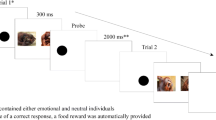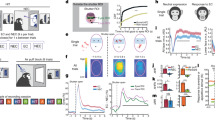Abstract
We examined attentional biases for social and non-social emotional stimuli in young adult men and compared the results to those of male rhesus monkeys (Macaca mulatta) previously tested in a similar dot-probe task (King et al. in Psychoneuroendocrinology 37(3):396–409, 2012). Recognition memory for these stimuli was also analyzed in each species, using a recognition memory task in humans and a delayed non-matching-to-sample task in monkeys. We found that both humans and monkeys displayed a similar pattern of attentional biases toward threatening facial expressions of conspecifics. The bias was significant in monkeys and of marginal significance in humans. In addition, humans, but not monkeys, exhibited an attentional bias away from negative non-social images. Attentional biases for social and non-social threat differed significantly, with both species showing a pattern of vigilance toward negative social images and avoidance of negative non-social images. Positive stimuli did not elicit significant attentional biases for either species. In humans, emotional content facilitated the recognition of non-social images, but no effect of emotion was found for the recognition of social images. Recognition accuracy was not affected by emotion in monkeys, but response times were faster for negative relative to positive images. Altogether, these results suggest shared mechanisms of social attention in humans and monkeys, with both species showing a pattern of selective attention toward threatening faces of conspecifics. These data are consistent with the view that selective vigilance to social threat is the result of evolutionary constraints. Yet, selective attention to threat was weaker in humans than in monkeys, suggesting that regulatory mechanisms enable non-anxious humans to reduce sensitivity to social threat in this paradigm, likely through enhanced prefrontal control and reduced amygdala activation. In addition, the findings emphasize important differences in attentional biases to social versus non-social threat in both species. Differences in the impact of emotional stimuli on recognition memory between monkeys and humans will require further study, as methodological differences in the recognition tasks may have affected the results.



Similar content being viewed by others
References
Abercrombie HC, Chambers AS, Greischar L, Monticelli RM (2008) Orienting, emotion, and memory: phasic and tonic variation in heart rate predicts memory for emotional pictures in men. Neurobiol Learn Mem 90:644–650. doi:10.1016/j.nlm.2008.08.001
Anderson AK, Yamaguchi Y, Grabski W, Lacka D (2006) Emotional memories are not all created equal: evidence for selective memory enhancement. Learn Mem 13(6):711–718. doi:10.1101/lm.388906
Bar-Haim Y, Lamy D, Pergamin L, Bakermans-Kranenburg MJ, van IMH (2007) Threat-related attentional bias in anxious and nonanxious individuals: a meta-analytic study. Psychol Bull 133(1):1–24. doi:10.1037/0033-2909.133.1.1
Bar-Haim Y, Holoshitz Y, Eldar S, Frenkel TI, Muller D, Charney DS, Pine DS, Fox NA, Wald I (2010) Life-threatening danger and suppression of attention bias to threat. Am J Psychiatry 167(6):694–698. doi:10.1176/appi.ajp.2009.09070956
Baumeister RF, Bratslavsky E, Finkenauer C, Vohs KD (2001) Bad is stronger than good. Rev Gen Psychol 5(4):323–370. doi:10.1037/1089-2680.5.4.323
Bishop SJ (2008) Neural mechanisms underlying selective attention to threat. Ann NY Acad Sciences 1129(1):141–152. doi:10.1196/annals.1417.016
Blanchette I (2006) Snakes, spiders, guns, and syringes: how specific are evolutionary constraints on the detection of threatening stimuli? Q J Exp Psychol 59(8):1484–1504. doi:10.1080/02724980543000204
Bovet D, Vauclair J (2000) Picture recognition in animals and humans. Behav Brain Res 109:143–165. doi:10.1016/S0166-4328(00)00146-7
Bradley BP, Mogg K, White J, Groom C, de Bono J (1999) Attentional bias for emotional faces in generalized anxiety disorder. Br J Clin Psychol 38(Pt 3):267–278. doi:10.1348/014466599162845
Brosch T, Sharma D (2005) The role of fear-relevant stimuli in visual search: a comparison of phylogenetic and ontogenetic stimuli. Emotion 5(3):360–364. doi:10.1037/1528-3542.5.3.360
Brosch T, Sander D, Scherer KR (2007) That baby caught my eye… attention capture by infant faces. Emotion 7(3):685–689. doi:10.1037/1528-3542.7.3.685
Brosch T, Sander D, Pourtois G, Scherer KR (2008) Beyond fear: rapid spatial orienting toward positive emotional stimuli. Psychol Sci 19(4):362–370. doi:10.1111/j.1467-9280.2008.02094.x
Cacioppo JT, Gardner WL (1999) Emotion. Ann Rev Psychol 50(1):191–214. doi:10.1146/annurev.psych.50.1.191
Cahill L, McGaugh JL (1995) A novel demonstration of enhanced memory associated with emotional arousal. Conscious Cogn 4(4):410–421. doi:10.1006/ccog.1995.1048
Cahill L, McGaugh JL (1998) Mechanisms of emotional arousal and lasting declarative memory. Trends Neurosci 21(7):294–299. doi:10.1016/S0166-2236(97)01214-9
Carlson JM, Fee AL, Reinke KS (2009) Backward masked snakes and guns modulate spatial attention. Evol Psychol 7(4):534–544
Carretié L, Hinojosa JA, Mercado F, Tapia M (2005) Cortical response to subjectively unconscious danger. Neuroimage 24(3):615–623. doi:10.1016/j.neuroimage.2004.09.009
Cisler JM, Koster EH (2010) Mechanisms of attentional biases towards threat in anxiety disorders: an integrative review. Clin Psychol Rev 30(2):203–216. doi:10.1016/j.cpr.2009.11.003
Cook M, Mineka S (1989) Observational conditioning of fear to fear-relevant versus fear-irrelevant stimuli in rhesus monkeys. J Abnorm Psychol 98(4):448–459. doi:10.1037/0021-843X.98.4.448
Cook M, Mineka S (1990) Selective associations in the observational conditioning of fear in rhesus monkeys. J Exp Psychol Anim Behav Process 16(4):372–389. doi:10.1037/0097-7403.16.4.372
Cooper RM, Langton SR (2006) Attentional bias to angry faces using the dot-probe task? It depends when you look for it. Behav Res Ther 44:1321–1329. doi:10.1016/j.brat.2005.10.004
Derryberry D, Reed MA (2002) Anxiety-related attentional biases and their regulation by attentional control. J Abnorm Psychol 111(2):225–236
Fagot J, Martin-Malivel J, Depy D (1999) What is the evidence for an equivalence between objects and pictures in birds and nonhuman primates? Cah Psychol Cogn Curr Psychol Cogn 18:923–949
Fani N, Jovanovic T, Ely TD, Bradley B, Gutman D, Tone EB, Ressler KJ (2012) Neural correlates of attention bias to threat in post-traumatic stress disorder. Biol Psychol 90(2):134–142. doi:10.1016/j.biopsycho.2012.03.001
Fox E, Lester V, Russo R, Bowles RJ, Pichler A, Dutton K (2000) Facial expressions of emotion: are angry faces detected more efficiently? Cogn Emot 14(1):61–92. doi:10.1080/026999300378996
Fox E, Ridgewell A, Ashwin C (2009) Looking on the bright side: biased attention and the human serotonin transporter gene. Proc R Soc B: Biol Sci 276(1663):1747–1751. doi:10.1098/rspb.2008.1788
Fromberger P, Jordan K, von Herder J, Steinkrauss H, Nemetschek R, Stolpmann G, Muller JL (2011) Initial orienting towards sexually relevant stimuli: preliminary evidence from eye movement measures. Arch Sex Behav. doi:10.1007/s10508-011-9816-3
Grady CL, Hongwanishkul D, Keightley M, Lee W, Hasher L (2007) The effect of age on memory for emotional faces. Neuropsychology 21(3):371–380. doi:10.1037/0894-4105.21.3.371
Hansen CH, Hansen RD (1988) Finding the face in the crowd: an anger superiority effect. J Pers Soc Psychol 54(6):917–924. doi:10.1037/0022-3514.54.6.917
Isaacowitz DM, Wadlinger HA, Goren D, Wilson HR (2006) Is there an age-related positivity effect in visual attention? A comparison of two methodologies. Emotion 6(3):511–516. doi:10.1037/1528-3542.6.3.511
Jackson MC, Wu C-Y, Linden DEJ, Raymond JE (2009) Enhanced visual short-term memory for angry faces. J Exp Psychol Hum Percept Perform 35(2):363–374. doi:10.1037/a0013895
Joormann J, Gotlib IH (2007) Selective attention to emotional faces following recovery from depression. J Abnorm Psychol 116:80–85. doi:10.1037/0021-843X.116.1.80
Judge PG, Kurdziel LB, Wright RM, Bohrman JA (2012) Picture recognition of food by macaques (Macaca silenus). Anim Cogn 15:313–325. doi:10.1007/s10071-011-0455-9
Kano F, Tanaka M, Tomonaga M (2008) Enhanced recognition of emotional stimuli in the chimpanzee (Pan troglodytes). Anim Cogn 11:517–524. doi:10.1007/s10071-008-0142-7
Keightley ML, Chiew KS, Anderson JA, Grady CL (2011) Neural correlates of recognition memory for emotional faces and scenes. Soc Cogn Affect Neurosci 6(1):24–37. doi:10.1093/scan/nsq003
Kensinger EA, Krendl AC, Corkin S (2006) Memories of an emotional and a nonemotional event: effects of aging and delay interval. Exp Aging Res 32(1):23–45. doi:10.1080/01902140500325031
King HM, Kurdziel LB, Meyer JS, Lacreuse A (2012) Effects of testosterone on attention and memory for emotional stimuli in male rhesus monkeys. Psychoneuroendocrinology 37(3):396–409. doi:10.1016/j.psyneuen.2011.07.010
Koster EH, Crombez G, Verschuere B, De Houwer J (2004) Selective attention to threat in the dot probe paradigm: differentiating vigilance and difficulty to disengage. Behav Res Ther 42(10):1183–1192. doi:10.1016/j.brat.2003.08.001
Koster EHW, Verschuere B, Crombez G, Van Damme S (2005) Time-course of attention for threatening pictures in high and low trait anxiety. Behav Res Ther 43:1087–1098. doi:10.1016/j.brat.2004.08.004
Koster EH, Crombez G, Verschuere B, Van Damme S, Wiersema JR (2006) Components of attentional bias to threat in high trait anxiety: facilitated engagement, impaired disengagement, and attentional avoidance. Behav Res Ther 44(12):1757–1771
MacLeod C, Mathews A, Tata P (1986) Attentional bias in emotional disorders. J Abnorm Psychol 95(1):15–20. doi:10.1037/0021-843X.95.1.15
Mather M, Carstensen LL (2003) Aging and attentional biases for emotional faces. Psychol Sci 14(5):409–415. doi:10.1111/1467-9280.01455
Mineka S, Ohman A (2002) Phobias and preparedness: the selective, automatic, and encapsulated nature of fear. Biol Psychiatry 52(10):927–937. doi:10.1016/S0006-3223(02)01669-4
Mishkin M, Delacour J (1975) An analysis of short-term visual memory in the monkey. J Exp Psychol Animal Behav 1:326–334
Mogg K, Bradley BP (1998) A cognitive-motivational analysis of anxiety. Behav Res Ther 36(9):809–848. doi:10.1016/S0005-7967(98)00063-1
Mogg K, Bradley BP, Williams R (1995) Attentional bias in anxiety and depression: the role of awareness. Br J Clin Psychol 34(Pt 1):17–36. doi:10.1111/j.2044-8260.1995.tb01434.x
Monk CS, Zhuang J, Curtis WJ, Ofenloch IT, Tottenham N, Nelson CA, Hu X (2002) Human hippocampal activation in the delayed matching–and nonmatching-to-sample memory tasks: an event-related functional MRI approach. Behav Neurosci 116(4):716–721. doi:10.1037/0735-7044.116.4.716
Ohman A, Lundqvist D, Esteves F (2001) The face in the crowd revisited: a threat advantage with schematic stimuli. J Pers Soc Psychol 80(3):381–396. doi:10.1037/0022-3514.80.3.381
Parron C, Call J, Fagot J (2008) Behavioural responses to photographs by pictorially naive baboons (Papio anubis), gorillas (Gorilla gorilla) and chimpanzees (Pan troglodytes). Behav Process 78:351–357. doi:10.1016/j.beproc.2008.01.019
Peeters G, Czapinski J (1990) Positive-negative asymmetry in evaluations: the distinctions between affective and informational negativity effects. Eur Rev Soc Psychol 1:33–60. doi:10.1080/14792779108401856
Pratto F, John OP (1991) Automatic vigilance: the attention-grabbing power of negative social information. J Pers Soc Psychol 61(3):380–391. doi:10.1037/0022-3514.61.3.380
Sergerie K, Lepage M, Armony JL (2005) A face to remember: emotional expression modulates prefrontal activity during memory formation. NeuroImage 24(2):580–585. doi:10.1016/j.neuroimage.2004.08.051
Sharot T, Delgado MR, Phelps EA (2004) How emotion enhances the feeling of remembering. Nat Neurosci 7(12):1376–1380. doi:10.1038/nn1353
Shibasaki M, Kawai N (2009) Rapid detection of snakes by Japanese monkeys (Macaca fuscata): an evolutionarily predisposed visual system. J Comp Psychol 123(2):131–135. doi:10.1037/a0015095
Smith NK, Cacioppo JT, Larsen JT, Chartrand TL (2003) May I have your attention, please: electrocortical responses to positive and negative stimuli. Neuropsychologia 41(2):171–183. doi:10.1016/S0028-3932(02)00147-1
Talmi D, Schimmack U, Paterson T, Moscovitch M (2007) The role of attention and relatedness in emotionally enhanced memory. Emotion 7(1):89–102. doi:10.1037/1528-3542.7.1.89
Taylor SE (1991) Asymmetrical effects of positive and negative events: the mobilization-minimization hypothesis. Psychol Bull 110:67–85. doi:10.1037/0033-2909.110.1.67
Tian Q, Smith JC (2011) Attentional bias to emotional stimuli is altered during moderate- but not high-intensity exercise. Emotion 11:1415–1424. doi:10.1037/a0023568
Tompkins ML, Hemani MJ, Jutras LA, Parr LA, Buffalo EA (2009) Enhanced memory for conspecific faces in rhesus macaques. Soc Neurosci Abstract 480.2, Chicago
Watson KK, Ghodasra JH, Furlong MA, Platt ML (2012) Visual preferences for sex and status in female rhesus macaques. Anim Cogn 15(3):401–407. doi:10.1007/s10071-011-0467-5
Wilson E, MacLeod C (2003) Contrasting two accounts of anxiety-linked attentional bias: selective attention to varying levels of stimulus threat intensity. J Abnorm Psychol 112(2):212–218. doi:10.1037/0021-843X.112.2.212
Yiend J, Mathews A (2001) Anxiety and attention to threatening pictures. Q J Exp Psychol A 54(3):665–681. doi:10.1080/713755991
Zola SM, Squire LR, Teng E, Stefanacci L, Buffalo EA, Clark RE (2000) Impaired recognition memory in monkeys after damage limited to the hippocampal region. J Neurosci 20(1):451–463
Acknowledgments
This research was supported in part by a mini-grant from the UMass College of Natural Sciences. We thank Akshata Sonni and the many students who participated in data collection, as well as Matthew Davidson and Casey DeBuse for their help with E-Prime. We are grateful to the Center for Research on Families for providing statistical expertise.
Author information
Authors and Affiliations
Corresponding author
Rights and permissions
About this article
Cite this article
Lacreuse, A., Schatz, K., Strazzullo, S. et al. Attentional biases and memory for emotional stimuli in men and male rhesus monkeys. Anim Cogn 16, 861–871 (2013). https://doi.org/10.1007/s10071-013-0618-y
Received:
Revised:
Accepted:
Published:
Issue Date:
DOI: https://doi.org/10.1007/s10071-013-0618-y




